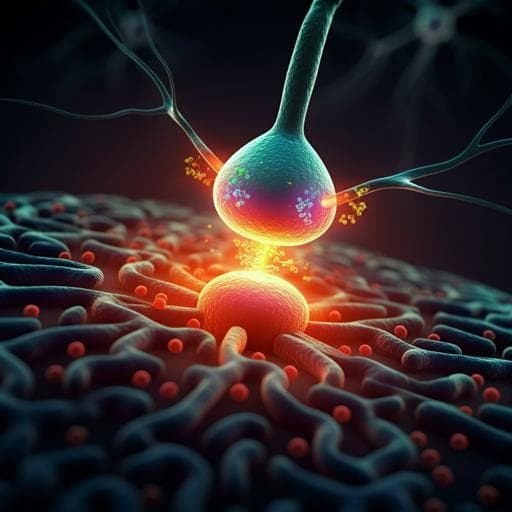
Psychology
Haploinsufficiency of the Parkinson’s disease gene synaptojanin1 is associated with abnormal responses to psychomotor stimulants and mesolimbic dopamine signaling
J. I. Mejaes, J. Saenz, et al.
Explore the critical role of the synaptojanin-1 gene in dopamine-related disorders as researchers Jennifer I. Mejaes, Jacqueline Saenz, Chris O'Brien, Carina M. Pizzano, Ping-Yue Pan, and David J. Barker investigate the impact of SYNJ1 deficiencies on reward processing and motivated behavior in mice. Discover how these findings uncover abnormal mesolimbic dopamine signaling and the implications for therapeutic strategies.
~3 min • Beginner • English
Introduction
Parkinson’s disease (PD) involves dysregulated dopamine (DA) signaling and dopaminergic neuron vulnerability, with motivational and goal-directed deficits often preceding motor symptoms. The PARK gene SYNJ1 (PARK20), encoding synaptojanin1, is essential for synaptic vesicle recycling and has been implicated in PD and other DA-related neuropsychiatric conditions. Prior work shows Synj1 haploinsufficiency leads to dopaminergic terminal loss and α-synuclein accumulation, and cocaine can drive Synj1-sensitive dopamine transporter (DAT) trafficking. The present study asks how Synj1 haploinsufficiency affects mesolimbic DA function, reward processing, and motivated behavior, testing the hypothesis that Synj1+/- mice display altered psychostimulant reward and DA kinetics, potentially via DAT dysfunction, while basic hedonic and effort-related behaviors remain largely intact.
Literature Review
The introduction surveys genetic links to PD (PARK genes), highlighting shared pathways that converge on DA dysregulation. SYNJ1 mutations have been associated with parkinsonism and other disorders (autism, bipolar disorder, schizophrenia). Synaptojanin1’s roles in synaptic vesicle recycling and PI(4,5)P2 metabolism are well-established, and prior Synj1-deficient mouse studies report dopaminergic terminal loss, α-synuclein accumulation, and motor coordination impairments with age. DAT trafficking depends on endocytic pathways, and recent work shows Synj1 influences cocaine-induced DAT internalization. Motivational disturbances and blunted reward sensitivity are common in PD. These findings motivate a detailed assessment of motivated behavior and mesolimbic DA signaling in Synj1 haploinsufficiency.
Methodology
Subjects: Sex- and age-matched Synj1+/- mice and Synj1+/+ littermates (total n≈77 across assays), 6–8 months old at experiment start. Animals were group-housed on a 12 h light/dark cycle with ad libitum food/water unless otherwise noted. A balanced initial cohort (10 females, 12 males) was followed by an additional male cohort as technical replicate.
Behavioral battery and order: Day 1 elevated plus maze (EPM) and open field (OF); Days 2–5 sucrose preference test (SPT); Days 6–20 operant conditioning (FR1→FR3) for sucrose; Day 21 progressive ratio; Days 22–33 cocaine conditioned place preference (CPP) with drug-primed reinstatement. A separate naïve cohort underwent object location memory (OLM) testing (Days 1–8) as a control for spatial memory.
EPM: Four-arm plus maze (30×5 cm arms; two open, two closed with 15 cm walls), 5-min exploration after 30-min cage habituation. ANY-maze recorded time in arms, entries, and locomotion. Groups: Synj1+/+ males (n=12), females (n=5); Synj1+/- males (n=12), females (n=6).
Open Field: 40 cm tall, 100 cm^3 box; 30-min cage habituation then 30-min exploration, tracked by ANY-maze. Same group sizes as EPM.
Sucrose Preference Test: Single housing with two 15 mL sipper bottles (overnight water acclimation), then 1% sucrose vs water for 2 days. Bottles weighed twice daily; positions alternated to avoid side bias. Consumption expressed as proportion of total intake.
Operant conditioning for sucrose and Progressive Ratio: Food-deprived to ~85% body weight for ~1 week. Operant chambers (Med Associates) with two retractable levers and a retractable sipper (8% sucrose). Autoshaping (right lever→sipper), then FR1 to acquisition criterion (>30 active presses/day for ≥5 consecutive days), then FR3 for 4 days. Progressive ratio test (linear increment by 3: 1, 4, 7, …) until response cessation; breakpoint recorded. Groups: Synj1+/+ males (n=12), females (n=5); Synj1+/- males (n=12), females (n=6).
Cocaine CPP: Three-compartment apparatus (striped vs black/grated large zones, small center). Habituation 45 min, then pretest (15 min), followed by 4 biased conditioning days: AM saline (0.3 mL 0.9% i.p.) in least-preferred side (30 min), PM cocaine (15 mg/kg i.p.) in opposite side (30 min). Post-test (15 min). Groups similar; one male failed post-test.
Object Location Memory (OLM): Naïve cohort Synj1+/+ males (n=5), females (n=6); Synj1+/- males (n=11), females (n=7). Six days of box habituation (5 min/day), Day 7 training with two objects (10 min), Day 8 24-h later test with one object displaced (5 min). Discrimination index computed as (displaced−static)/(displaced+static).
NAc dLight fiber photometry: AAV5-hSyn-dLight1.2-WPRE injected into NAc (AP +1.25, ML +0.75, DV −4.55), 300 nL at 50 nL/min; optic fiber implanted 100 μm above. Perioperative analgesia/antibiotics provided. Recording in OF with dual-excitation (490/405 nm) and photodetector via Doric minicube; signals digitized at 1 kHz (TDT RZ2/Synapse). Analysis via pMAT/MATLAB. Ascending daily injections: saline, 10, 15, 20 mg/kg cocaine. Groups: Synj1+/+ males (n=7), females (n=6); Synj1+/- males (n=6), females (n=7).
Western blot: Independent ~10-month-old cohort received 4 daily i.p. injections (saline or cocaine 15 mg/kg/day) mirroring CPP schedule. Regions collected 30 min after final injection: midbrain and striatum. Lysis in Tris/NaCl/Triton buffer with protease/phosphatase inhibitors; centrifugation; BCA assay. SDS-PAGE (NuPAGE 4–12% Bis-Tris), transfer, blocking (5% BSA), primary anti-DAT (1:1000, Millipore AB2231) and β-actin (1:1000, CST 3700S), HRP detection. Antibody validation with a KO-validated DAT antibody replicated for striatum. Bands quantified in ImageJ; DAT normalized to β-actin and to Synj1+/+ saline mean; 2–3 technical replicates/sample.
Statistics: One-, two-, three-way ANOVAs or generalized linear models (SPSS/Prism). Between-subjects factors: genotype (Synj1+/- vs Synj1+/+) and sex. Checked homogeneity and normality; Greenhouse–Geisser correction as needed; Sidak post hoc tests. GLM used for CPP due to non-normality; ANOVA results cross-checked with GLM.
Key Findings
- Exploratory/avoidance behavior: In EPM, all groups spent more time in closed arms (Arm: F(2,62)=124.01, p<0.001); no sex or genotype differences. In OF, females traveled farther than males (Sex: F(1,31)=16.44, p<0.001); no genotype effect.
- Hedonic responding: All mice preferred sucrose over water (Bottle: F(1,31)=14.27, p<0.001); no sex or genotype differences in proportion consumed.
- Operant learning and effort: All groups acquired lever pressing similarly and responded more under FR3 than FR1 (Schedule: F(1,31)=37.11, p<0.001). On the last FR3 day, all pressed active > inactive lever (Lever: F(1,19)=92.19, p<0.0001) with a lever*sex*genotype interaction (F(3,19)=3.174, p<0.05). Synj1+/- males pressed the active lever more than Synj1+/+ males, Synj1+/+ females, and Synj1+/- females (all t(38)≥2.84, p<0.05). Progressive ratio breakpoints did not differ by sex or genotype.
- Cocaine CPP and locomotion: During conditioning, cocaine increased locomotion vs saline across all groups (Treatment: F(1,31)=341.7, p<0.0001) without sex/genotype differences. At post-test, all showed cocaine-paired preference (χ2(1)=217.70, p<0.001), but Synj1+/- males exhibited a weaker preference vs Synj1+/+ males and Synj1+/+ females (GLM sex*genotype*zone: χ2(1)=4.35, p<0.05; pairwise t(34)>2.00, p<0.05).
- Spatial memory control: OLM showed higher discrimination index at test vs training for all mice (F(1,25)=4.57, p<0.05), with no genotype effect or interaction, indicating intact spatial memory in Synj1+/- mice.
- NAc DA photometry: Cocaine produced dose-dependent increases in dLight signal amplitude (Dose: F(1.75,36.7)=20.93, p<0.0001); 20 mg/kg > 10 mg/kg (p<0.01). No amplitude differences by sex or genotype. Kinetic modeling revealed longer latency to peak (T_peak) in Synj1+/- vs Synj1+/+ (Genotype: F(1,23)=4.3, p<0.05). Half-decay (T1/2) showed a sex effect with females > males (Sex: F(1,58)=11.26, p<0.01); no genotype effect.
- DAT expression (western blots): After repeated cocaine, midbrain DAT showed sex and treatment/genotype/sex interaction (Sex: F(1,42)=6.9, p<0.05; Treatment*Genotype*Sex: F(1,42)=7.76, p<0.01). Cocaine increased DAT in Synj1+/+ males vs Synj1+/+ females (p<0.05). In striatum, similar pattern (Sex: F(1,42)=24.24, p<0.0001; Treatment*Genotype*Sex: F(1,42)=7.74, p<0.01) with elevated DAT in cocaine-treated Synj1+/+ males vs Synj1+/+ females (p<0.05) and higher saline baseline in Synj1+/- males vs Synj1+/- females (p<0.001). Authors interpret that cocaine typically increases DAT in males, but this adaptive increase is absent in Synj1+/- males who already have elevated striatal DAT at baseline.
Discussion
Findings indicate that Synj1 haploinsufficiency does not broadly disrupt exploratory behavior, avoidance, hedonic preference for sucrose, or overall motivation in standard tasks. However, male-specific differences emerged: Synj1+/- males showed greater sucrose-seeking on the last FR3 day and a weakened cocaine-conditioned place preference. Photometry revealed intact amplitude of cocaine-evoked NAc DA signals but altered kinetics: Synj1+/- mice of both sexes had delayed T_peak, while females (regardless of genotype) exhibited slower decay (longer T1/2). Western blot data suggest sex- and genotype-dependent DAT regulation: cocaine increased DAT expression in Synj1+/+ males but not in Synj1+/- males, which appeared to have elevated baseline DAT in striatum. Together, these results support that Synj1-related alterations in vesicular trafficking intersect with DAT trafficking/function, producing abnormal mesolimbic DA kinetics that blunt cocaine reward in males. The preserved CPP in Synj1+/- females despite delayed T_peak may relate to their prolonged DA decay, possibly reflecting sex-related neurosteroid effects and resilience in DA-related pathophysiology. The data align with clinical observations that PD and dopaminergic dysfunction present sex differences, and they underscore that Synj1-linked mesolimbic abnormalities become most evident under pharmacologic challenge rather than baseline conditions.
Conclusion
This study demonstrates that Synj1 haploinsufficiency produces abnormal mesolimbic dopamine signaling characterized by delayed peak DA responses to cocaine and sex-dependent decay kinetics, without broadly impairing hedonic or exploratory behaviors. Male Synj1+/- mice show attenuated cocaine CPP and altered DAT regulation (elevated baseline striatal DAT and lack of cocaine-induced DAT upregulation) consistent with DAT dysfunction. These results extend the role of SYNJ1 beyond nigrostriatal motor circuits to mesolimbic reward pathways and support targeting Synj1/DAT-related vesicular trafficking mechanisms as potential therapeutics for DA-associated neurological and psychiatric disorders. Future work should assess age-related progression of these phenotypes, causal links between Synj1 and DAT trafficking in vivo, and sex-specific mechanisms (e.g., hormonal modulation) that shape cocaine pharmacodynamics and DA kinetics.
Limitations
- Age window: Behavioral and photometry assessments were conducted primarily at 6–8 months; prior work indicates more pronounced motor phenotypes at 12 months, so age-related progression of motivational/DA kinetic deficits was not directly tested here.
- Genotype scope: Only Synj1 haploinsufficient (Synj1+/-) mice were examined; homozygous deletion is non-viable, limiting genotype comparisons.
- Pharmacological challenge: Key mesolimbic abnormalities emerged under experimenter-administered cocaine; generalization to other rewards/stressors or self-administration was not tested.
- Sex/sample balance: Some groups, particularly females, had smaller n than males in certain assays, which may limit power to detect sex-by-genotype interactions.
- DAT measures: Western blots assessed DAT after repeated dosing and at one post-injection time point; dynamic surface vs total DAT and regional microdomain-specific changes were not resolved.
Related Publications
Explore these studies to deepen your understanding of the subject.







